





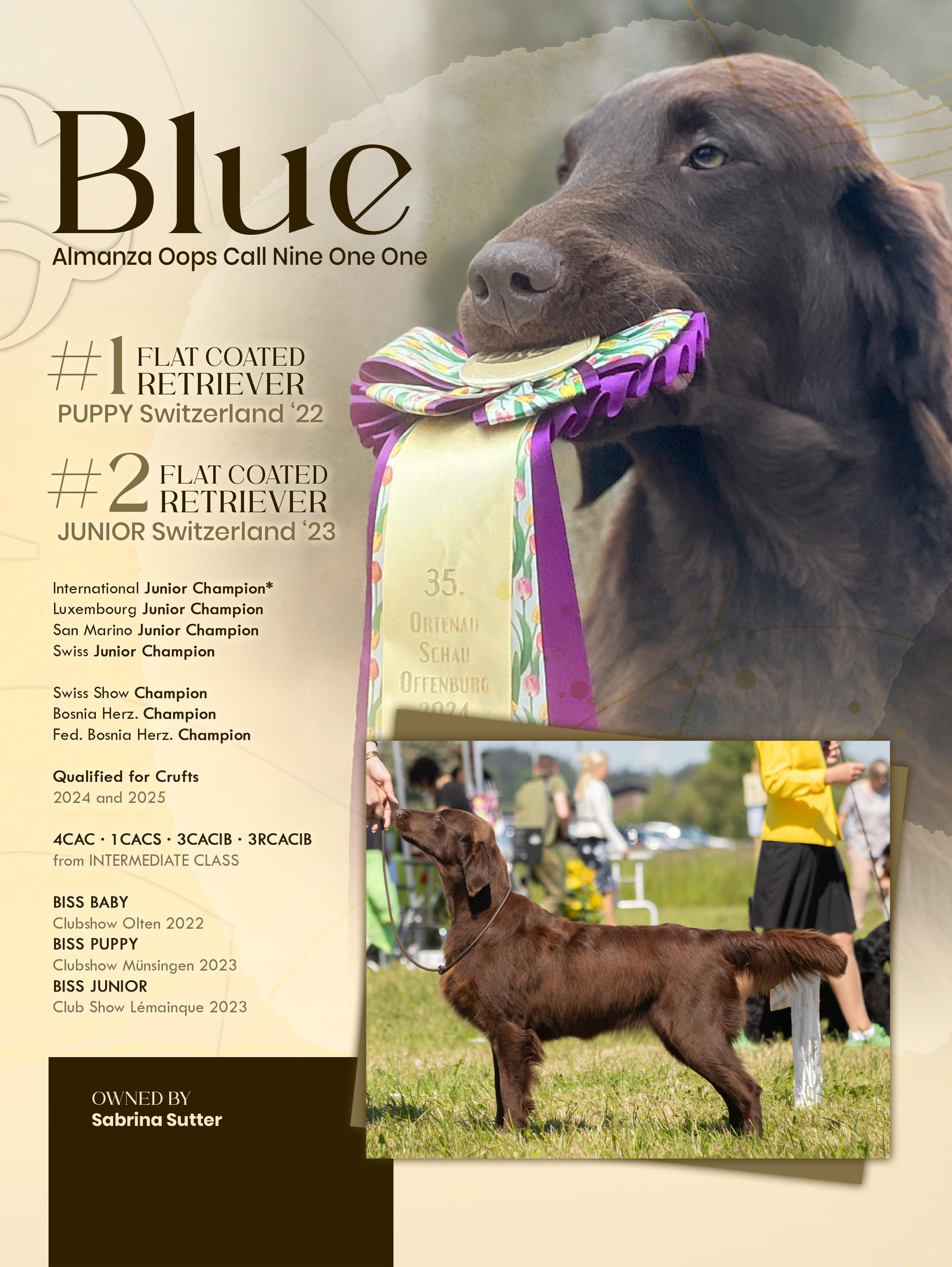


















Dear readers,
In today’s digital age, our mission is to blend convenience with delight for our cherished readers. In a world where judges and exhibitors invest significant time commuting to shows, our phones have become indispensable sources of information and entertainment. Embracing this reality, our team is thrilled to unveil the monthly digital edition of Best in Show Magazine Europe. This digital offering allows us to effortlessly engage with over 50,000 individuals in the sport, including judges, breeders, handlers, and dedicated subscribers each month.
In addition to our digital presence, we are actively curating a wealth of informative content across our social media platforms—from our website to our weekly newsletter, and on Facebook and Instagram. While I personally cherish the tactile experience of a printed copy, I am equally delighted to announce that we will be releasing our printed edition twice this year, culminating in our esteemed Annual edition.
Here’s to embracing the future with enthusiasm and anticipation! We hope you thoroughly enjoy this exceptional edition as we make our triumphant return.
Warm regards,





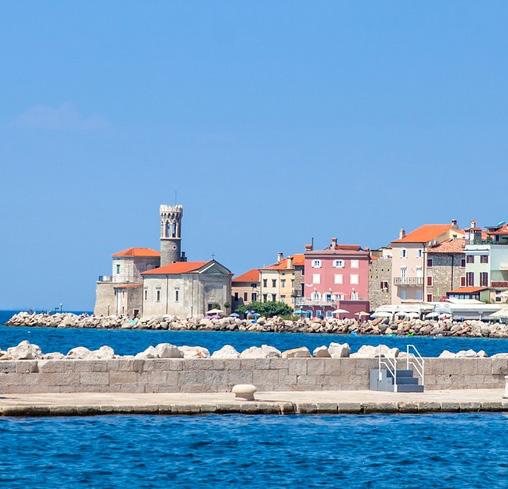





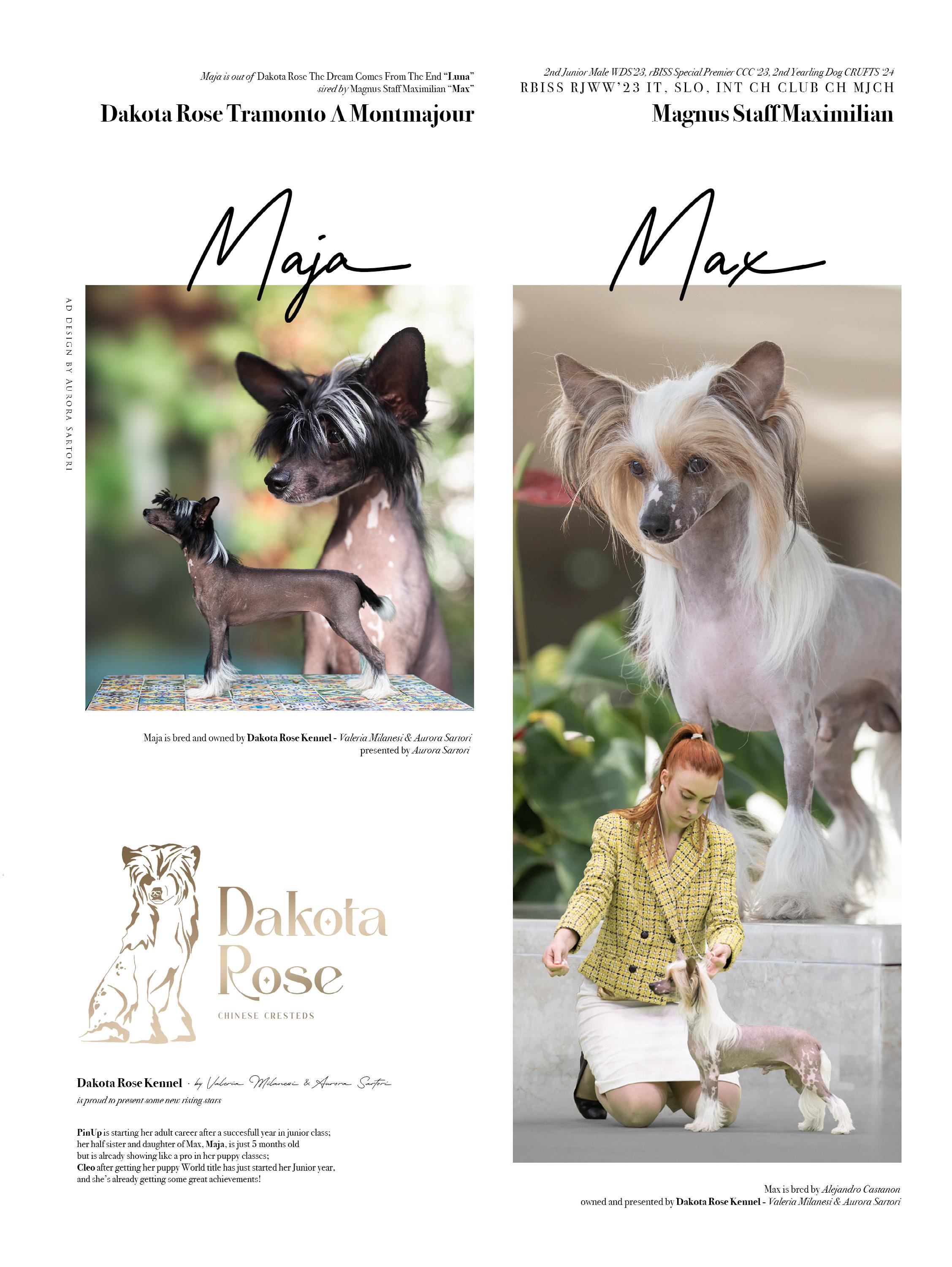

Can you take us through the beginnings of your journey with dogs—how it all started and what initially drew you to this world of canine companionship and competition?
As far back as I can remember, I have always been fascinated by dogs, not to mention the animal world in general. Furthermore, aesthetics and creativity have always attracted me and held a predominant place in my life. This is how I learned to become a groomer, which combined these two passions and gradually led me to dog shows. With my partner at the time, we had poodles, and I quickly felt an attraction to white dogs. This is how I discovered the Maltese, with whom I immediately fell in love due to their long, silky white coat and sweet, charming expression, as well as their whimsical temperament. I had an instant connection with the breed, which felt like a natural fit for me. I also consider myself


INTERVIEW WITH JUDGE
fortunate to have met someone like Ronny Engelen from the world-renowned kennel ‘Of Millmoor,’ who has sharpened my knowledge, always supported me, and provided me with insightful breeding advice. In addition, several trips to America have perfected my grooming knowledge; there was definitely a before and after Westminster.
Over the past 30 years, you have dedicated yourself to breeding Maltese, Poodles, Yorkshire Terriers, and Pomeranians under the esteemed kennel names “Supers Supers” and “My Supers,” achieving numerous World and European champions along the way. Could you share which dogs stand out as the highlights of your distinguished breeding career?
Obviously, all my dogs have been important to me. Providing them with daily care and living in close contact with them each day creates an unbreakable bond. Nevertheless, some may have had a more significant impact on my memory than others due to various details. Among them, two of my Maltese dogs, Tantalizer des Supers Supers and Funny Ladies Segarl, marked an era of my life with the numerous successes they achieved. Both were named Best Dog of the Year across all breeds, winning many Best in Show titles, as well as the European Championship (where Segarl won Best of Group 9). A few years later, I repeated these exact results with one of my Maltese boys, My Supers Epice, with whom I had the honor


of representing my country at the Eukanuba World Challenge in Long Beach.
In the 2000s, my white toy poodle, Xeliane des Supers Supers, was also proclaimed the best companion dog in my country and the 3rd best all-breeds dog. Xeliane won the world champion title twice. She was a little dog who loved to grace the rings with presence and dignity. She owned the ring.
I cannot help but mention my little Pomeranian, Linnanhaltijan Quartz, who was also one

of the loves of my life. This little boy shared every moment of my life. He accompanied me to work, to the supermarket—wherever possible, he was with me, even sleeping in my bed. In short, he shared my life from dawn until dusk. Additionally, he held numerous championship titles and was proclaimed Best Stud Dog for three consecutive years, along with a significant number of his offspring who also found success in the rings. Sadly, he passed away a few years ago. I always carry around my neck an amulet containing some of his ashes.
I currently live with one of his grandsons, now 9 years old, who has also achieved numerous championship titles, as well as being the great-grandson of his grandson.
What do you consider highlights of your breeding career?
Each step toward victory in the show ring represents, in my opinion, progress for the breeds I raise and deeply cherish. For three consecutive years, I was awarded the title of Best Breeder. This title recognized the number of dogs from my breeding program that achieved champion status worldwide during the preceding year. Some victories stand out, such as winning the group at the European Championship multiple times or Best in Show at the French Championship, which featured over 7,000 entries. All of my dogs have achieved at least 3 or 4 championship titles. Living in the heart of Europe has afforded me the opportunity to exhibit my dogs in many countries and accumulate multiple champion titles.

You have judged all over the world; what have been some of your most memorable assignments so far?
It is always a great honor when you are invited to judge the specialty of your own breed in any country, as I did to celebrate the 80th anniversary of the Poodle Club in Czechia. On several occasions, I have also had the honor of judging the “Champion of Champions” competitions in various countries. Furthermore, I had the great honor of judging Group 9 at the Winner Dog Show in Helsinki. This show is a major event in Europe, gathering over 9,000 dogs per day. However, I must admit that currently, the appointment I eagerly await is the Westminster Dog Show in New York. I have attended this exhibition numerous times in the past.
What do you wish every judge knew about the Pomeranian before assessing them in the ring?
The intrinsic qualities that one cannot forget in this breed are breed type, body proportions, and coat texture. Regrettably, in recent times, we frequently encounter specimens where the breed’s characteristics have been diluted, leading to a misguided direction for the breed.
What 3 dogs from the past do you wish you could have judged or owned from anywhere in the world?
I first need to mention a dog who was a cornerstone in my breeding program, as well as in many others throughout Europe. That dog was named Caramalta Motivator from a famous kennel in England, who enabled many
of us Maltese breeders to develop our bloodlines on solid foundations. This male was the result of several generations of breeding by prominent English breeders.
Then, I have a vivid memory of a magnificent Komondor at Westminster who won his group in 1993, Champion Lojosmegyi Dahu Digal. From a distance, this dog, with his floor-length cords and immaculate whiteness, could have been mistaken for a giant Maltese. It was a very impressive moment.
More recently, I had the chance to judge and meet a magnificent female Bloodhound, Loamy’s LanLaneSue, whose morphological characteristics matched her breed standard so well, as well as her typical gait. What drew me to her was her friendly and gentle temperament and expression, which could melt anyone’s heart.
The purpose of dog showing was (and should still be) to evaluate and “show off” breeding stock. Do you think for some breeders/owners it is becoming more about ribbons and rankings?
Absolutely and regrettably. The fundamental purpose of dog shows is to evaluate one’s own breeding or one’s own dog in order to maintain the correct trajectory dictated by the breed standard and to evolve positively for the fu-

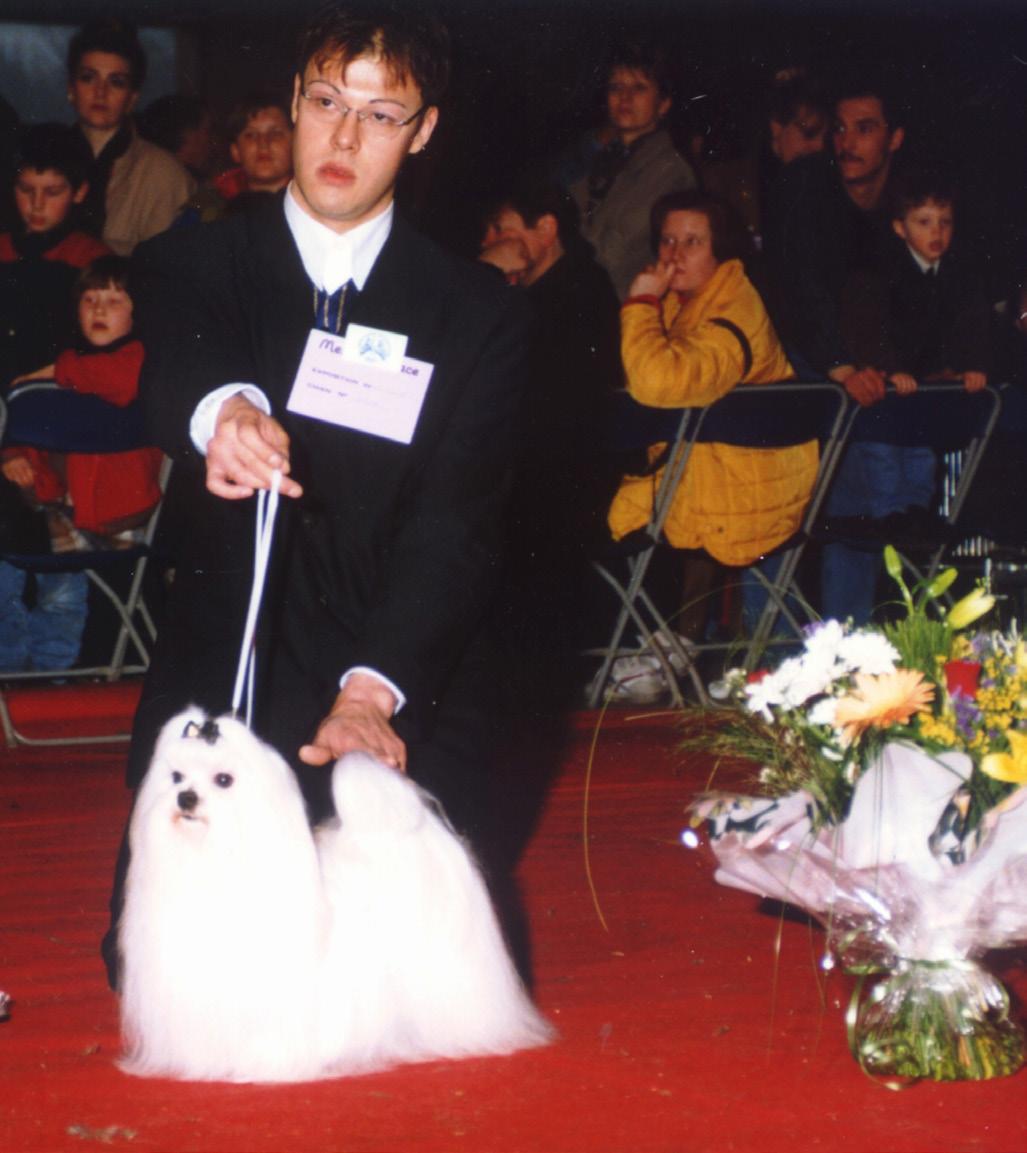
ture of the breed. If these conditions are not respected and only aim to achieve a champion title, self-critique is completely absent. It should be a self-assessment to evaluate the quality of our own journey within the breed. Unfortunately, this is a phenomenon that we encounter all too often in many breeds.
Who are some judges that have significantly influenced your decision to judge and your approach to judging? What qualities do you admire most in their judging style?
Over the years, I have been fortunate to be surrounded by multiple judges of great renown whom I deeply admire. I believe that
my education as a judge has been shaped over time by gathering diverse information from various judges, which has allowed me to handle certain situations. With this knowledge, I have developed my own ideas and structure for judging that I would have appreciated as an exhibitor. I am immensely grateful to everyone who has contributed to and supported me throughout my path. However, to avoid offending anyone, I won’t name individuals for fear of forgetting someone, but I truly appreciate all their contributions. Each day spent within our cynology brings me a wealth of new knowledge and enriches my experience. I wish to continue learning until the end.


You’ve been assigned to judge at the prestigious Westminster Dog Show in New York next year. How do you feel about this opportunity, and what are you most excited about when it comes to attending the event, especially considering that not many judges from Europe have received this honor?
It is indeed a tremendous honor and a culmination of years in cynology. There are no words to describe this feeling. This event at Westminster currently represents the pinnacle of my judging career. I have visited the Westminster Dog Show many times, during which I sometimes assisted handlers and presenters in preparing their dogs. Returning to New York for such an event is beyond what I could have ever imagined. I look forward to reconnecting with old friends and derive great pleasure from the experience.
What do you like to do most to relax and unwind?
I enjoy spending time at home when I am not judging. I live on the edge of a forest and love gardening, painting, taking long walks with my dogs, and working on decorations—basic things in general.
What dish do you most enjoy preparing at home, and which one never fails to excite you when you order it at a restaurant?
Generally, I enjoy cooking somewhat elaborate meals. Everyday cooking is not among my preferences. I believe that in many restau-

rants, the meal you can never go wrong with is a good pasta dish, and I absolutely love it. I am also a big fan of Asian cuisine, but I would never dare to venture into those preparations myself.
Lastly, amidst your judging experiences, have there been any humorous or lighthearted moments that stand out and you’d be willing to share?
There must have been many, but one that happens frequently stands out. I have a habit of asking for the age of the dogs I judge in relation to the class they are entered in, and it quite often happens that the handlers give me their own age instead. The response is always surprising when it comes to the age of a young dog, and someone tells you, “67 years old.” I am quite sure this has happened to many of us.





“Explore the hidden gem of the adriatic”

Nestled along the stunning Adriatic coastline, Koper is a captivating blend of history, culture, and natural beauty, often overlooked by travelers in favor of its more famous neighbors. This charming Slovenian town, with its Venetian architecture, vibrant port, and welcoming atmosphere, is a treasure trove waiting to be explored. In “Explore the Hidden Gem of the Adriatic: Travel Tips for Koper, Slovenia,” we will guide you through the best ways to experience this enchanting destination.

Koper’s medieval old town is a highlight, where cobblestone streets wind past ancient cathedrals and charming squares. The Praetorian Palace and Cathedral of the Assumption are must-visit landmarks that offer a glimpse into the town’s rich history and architectural heritage. Koper boasts beautiful beaches perfect for relaxation and water activities. The warm, clear waters of the Adriatic invite swimming and sunbathing, providing a delightful contrast to the cultural explorations inland.
Food lovers will revel in Koper’s local cuisine, which blends Mediterranean and Central European influences. Fresh seafood, olive oil, and fine wines are staples of the dining experience, with numerous seaside restaurants offering delectable dishes against a backdrop of stunning sea views. The town’s markets and festivals further enhance the cultural experience, showcasing local crafts, music, and traditions.
Whether you’re an adventure seeker, a history buff, or simply in need of a serene getaway, our travel tips will help you make the most of your visit to this undiscovered jewel of the Adriatic. Discover the best times to visit, hidden spots to explore, local delicacies to savor, and activities that capture the essence of Koper. Let us help you uncover the secrets of this hidden gem and create memories that will last a lifetime.
**Restaurants in Koper**
1. Gostilna Oljka - When visiting Istrian locales renowned for their Refošk and Malvazija wines, alongside authentic local culinary experiences, travelers are invited to pause outside Vanganel at Restaurant Oljka. Here, guests are warmly welcomed to an inn offering an authentic and unique homemade food experience, featuring the house specialty “Ombolo in the dough”. With a cozy atmosphere and a dedicated team of ambitious young professionals prepared to tackle new challenges, Oljka aims to cultivate a genuine sense of homey
warmth. The restaurant prides itself on harmonizing traditional flavors and heritage with the modern guest’s desires and preferences.
2. Capra - The Mediterranean restaurant Capra is open since 2014 and offers high quality locally inspired cuisine with an international touch in a magical atmosphere. Part of the 4-star Grand Koper hotel, just a few metres from the sea. Receiver of the Falstaff Award in 2021, 2022 and 2023, listed in Gault Millau Slovenia as one of the best restaurants.
3. Gostilna Pri Peclju - A family-run restaurant known for its warm hospital -


ity and authentic Slovenian dishes. Try their homemade pasta and local wines while soaking in the rustic ambiance.
4. Rizi Bizi - Situated near the beach, Rizi Bizi is celebrated for its innovative menu featuring a fusion of Slovenian and international flavors. Their outdoor terrace is perfect for enjoying meals al fresco.
5. Taverna Koper - Located in a historic building, Taverna Koper specializes in seafood and Istrian cuisine. Sample their grilled fish and regional wines while admiring the charming architecture of Old Town. **Sightseeing in Koper**
**Sightseeing in Koper**
1. Tito Square (Titov trg) - Explore Koper’s main square adorned with Venetian architecture, cafes, and the iconic Praetorian Palace. The square is a hub of cultural events and local life.
2. Koper Cathedral (Stolnica Marijinega vnebovzetja) - Visit this magnificent cathedral dating back to the 12th century. Admire its Gothic and Renaissance features, including impressive frescoes and ornate chapels.
3. Piran - Take advantage of your limited time on dry land with a panoramic bus tour along the Slovenian coast. After pickup from the cruise terminal, enjoy a comfortable drive along the
Gulf of Trieste and past quaint seaside villages, including Koper, Izola, and Portoroz. Once you arrival in Piran, enjoy two full hours of leisure time in the medieval town to use however you like.
3. Praetorian Palace (Pretorska palača)Delve into Koper’s history at the Praetorian Palace, a Venetian Gothic landmark housing the Koper City Museum. Explore exhibitions on maritime history and local art.
4. Žusterna Beach - Relax and unwind at Žusterna Beach, a popular spot for sunbathing and swimming. Enjoy panoramic views of the Adriatic Sea and indulge in water sports activities.
5. Muda Gate (Mestna vrata Muda) - Discover one of Koper’s medieval gates,

part of the city’s ancient defensive walls. Climb to the top for panoramic views of the city and surrounding landscapes.
6. Postojna Cave - The temperature in the cave is around 10°C/50ºF. Walking comfortable shoes and warm jackets are recommended, After a few kilometres ride from Postojna Cave you will experience the fairytale world of knights in an medieval marvel, more than 800 years old, the largest cave castle in the world, listed as one of the Guinness World Records. This is our usual proposal. If you want a signature tailor-made trip, we will prepare it just for you. Feel your unique travel experience de -

signed by local pleasure experts. Please feel free to approach us with any special ideas and interests that you desire and we’re sure we can handle it to your satisfaction.
Embrace the charm and beauty of Koper, Slovenia, where history meets the Mediterranean allure. Whether you’re savoring local delicacies at seaside restaurants, exploring ancient architecture, or relaxing on pristine beaches, Koper promises an enriching and unforgettable travel experience. Plan your itinerary wisely to make the most of your time in this hidden gem along the Adriatic coast.



The biggest canine event in France, the “Championnat de France”, was held this year in Montluçon, a city in the very center of France, 350 km south of Paris. It is a small city but it has a large expo center, not the most modern, but big, and with plenty of parking space around. The city is well-known among French dog lovers as it hosts several dog events every year. It is
affordable for clubs to rent the halls. This time, however, it had the honor of hosting this massive event, the Championnat, and the Breeds Specialty Show prior to the Championship. For the Specialty Show, 3496 dogs were entered, and for the Championnat, 5950, making a total of 9446 entries. That is huge and a real challenge to organize.
The city of Montluçon has only 34,000 inhabitants, and finding enough accommodation for all the judges, teams, and exhibitors was a real challenge. The judges and assisting teams were spread over several hotels in the city. Exhibitors came by caravan or motorhome or had to look for accommodation within a 100 km radius or more. On the other hand, the organization did not charge for parking or caravan space (except for electricity), and the entry fee for the dogs was relatively cheap. If the prices are too high, exhibitors do not enter extra dogs so that they can participate in the pairs and breeders groups. But if the price is fair, it makes a difference, as shown clearly by the high number of couples and groups on both days.
This show is the highlight of the year, and the title is highly coveted. People know it is a big show with high competition, and they relish that. It adds to the value of the title. And if you own a rare French breed, you can be sure not to be alone in your ring, but to face some competition. France is a country of dogs and has the most recognized national breeds by the FCI, about 60 in total. Many of the hunting dogs in groups 6 and 7 are rarely shown outside France or even within France itself. Many chateaux in France developed their own breeds over centuries to hunt in “meutes” (packs) or bred dogs specialized for the typical terrain or game in the area. Being invited to a show like this should be a must
for any judge who considers themselves a “real all-rounder”. Very few have ever seen these breeds in real life, let alone being able to distinguish them and learn their characteristics. After several years, I myself have learned a few, but I still make mistakes or forget their names. That is why a show like this is such a treat for me. Especially the “meutes” can leave a deep impression on you. I was fortunate to witness a pack of 30 to 40 “Poitevins” twirling around the “cavaliers” on their horses a few times. And when the hunting horns are blown, it ensures that it makes a lasting impression on your soul that you will never forget.
Some of the rare breeds belong to group 11, meaning they are not (yet) recognized by the FCI. The most promoted breed at the moment is the Cursinu, the national dog of Corsica (an island in the Mediterranean belonging to France). Other breeds include the Black and Tan Shepherd dog of the Alps and the Savoie, the Briquet de Provence, the Bruno St. Hubert Français, the Saint Usuge Spaniel, and the Pluricolor Poodle varieties. France is clearly dedicated to preserving its national breeds, but many of them are seldom seen outside France and are possibly endangered. Finding enthusiasts for these breeds may be a priority on the SCC’s agenda. Perhaps it’s time to promote them beyond France as well. The FCI should consider organizing a specialty show during the World and European Shows for all extremely rare breeds. If people are unfamiliar
with these breeds, they are less likely to be interested in owning one as a pet. Most people are attracted to something exotic and rare; it’s simply a matter of spotlighting them.
Three tents sheltered the commercial stands. Only the main sponsor stand and the stands of the Société Centrale Canine (the French Kennel Club) were located in the hall where the main ring was situated. The 68 rings were partly indoors and partly outdoors. Fortunately, the weather was not cold, and there was minimal rain, although the typically sunny French climate was absent. Nonetheless, it was ideal weather for the dogs. Inside the halls, lighting was dim, but once your eyes adjusted, it was manageable. The halls were illuminated by old fluorescent lamps, which were insufficient. Changing them to LED lights in the future would make a significant difference. Of course, this is not something that can be blamed on the organization. To add some color to the old ceilings, wide French tricolor cloths were hung under the lights along the length of each hall, but unfortunately, they did not brighten things up much. In contrast, the hall reserved for the main ring was well-lit. The floor was covered with light blue carpeting. The main ring itself had a red carpet, and at one end, there was a visually appealing podium composed of three circular platforms at different levels, draped in the colors of the French flag. It was truly a feast for the eyes. There were no seats or stands for spectators; only the fences could
be used for seating. Nevertheless, there was significant public interest every day until the very end. The program was packed with 30 events each day, but everything ran smoothly, and the two commentators did an excellent job providing commentary. However, a few judges took more time than planned and inadvertently drew attention away from the dogs. This is unprofessional and disrupts the schedule. Therefore, on Sunday, the tempo during the group judging was increased as it approached the end, which was regrettable as this is the most crucial part of the show.
A total of 68 judges were invited, representing 13 different nationalities, with 47 of them being French. I was pleasantly surprised to find statistics regarding the nationalities of the exhibitors. On Sunday, during the Championnat itself, 24 countries were represented. Of the 5549 dogs entered, the majority, 5549, were owned by French exhibitors, with only 401 dogs coming from 23 other countries, primarily Belgium and Italy, but also including entries from as far away as Azerbaijan and Brazil. There were also 10 entries from the UK and 2 from Ireland.
Alexandre Balzer, who resides near Montluçon in the Bourbon region of France, not only serves as the president of the Société Centrale Canine but also as the president of the Bourbonnais regional Club. He was extremely proud of the success of this event, and rightly so. The French Kennel Club stands out within the FCI because it is an integral
part of the Ministry of Agriculture of France. French breeds are considered cultural and heritage assets. The Ministry delegates the organization of breed registrations, events, and sports competitions to the Société and its affiliated clubs. In addition to national and international shows, hundreds of club shows and other canine events are organized throughout the country. While the Championnat de France is the most prestigious, the Société Centrale Canine also participates annually in the “Salon d’Agriculture” under the Ministry’s supervision, and at the end of September,
they will organize for the second time the “Semaine Nationale du Chien” (National Dog Week), where dogs will be celebrated across France. Numerous canine activities and demonstrations will be held during this week (visit www.semaineduchien. fr or #semaineduchien). This should be adopted by all countries worldwide! No other animal is as closely connected to humanity and serves in so many loyal ways that they deserve a week or day of recognition. The Société Centrale Canine maintains a vast Media Library, a unique resource under governmental supervision.

If you seek information on one of the rare French breeds, you can always inquire with the SCC (www.centrale-canine.fr). They will provide all the information you need. And if you wish to see these breeds in person, the Championnat is the place to be, always held in early June. If you happen to be in the area, do not hesitate to visit. Combine it with your holiday in France; you will not be disappointed. There is so much to learn and discover about French cynology. On Saturday, the Best In Show Judge was Ms. MATTERA Cassandra. She chose the well-presented Australian
Shepherd Airplane’s Still My Heart Forever, owned by Ludovic Gerona. On Sunday, the honor went to Mr. CONDO Pietro-Paolo, who selected the German Shepherd Siago de la Petite Laeticia, owned by Philippe Breinlen. Siago also won the Championnat last year. Winning such a significant show is a remarkable achievement. I’m sure Mr. Breinlen will be back next year! This was another successful Championship, wellorganized with a high number of entries and showcasing many rare breeds. Congratulations to the organizers; I look forward to the next edition.






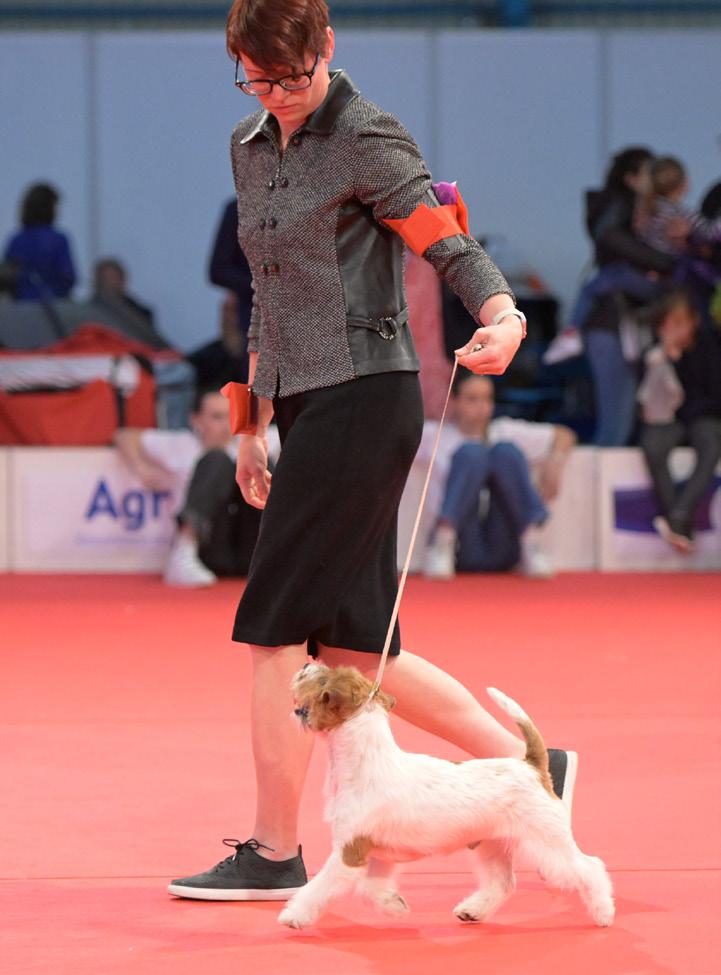






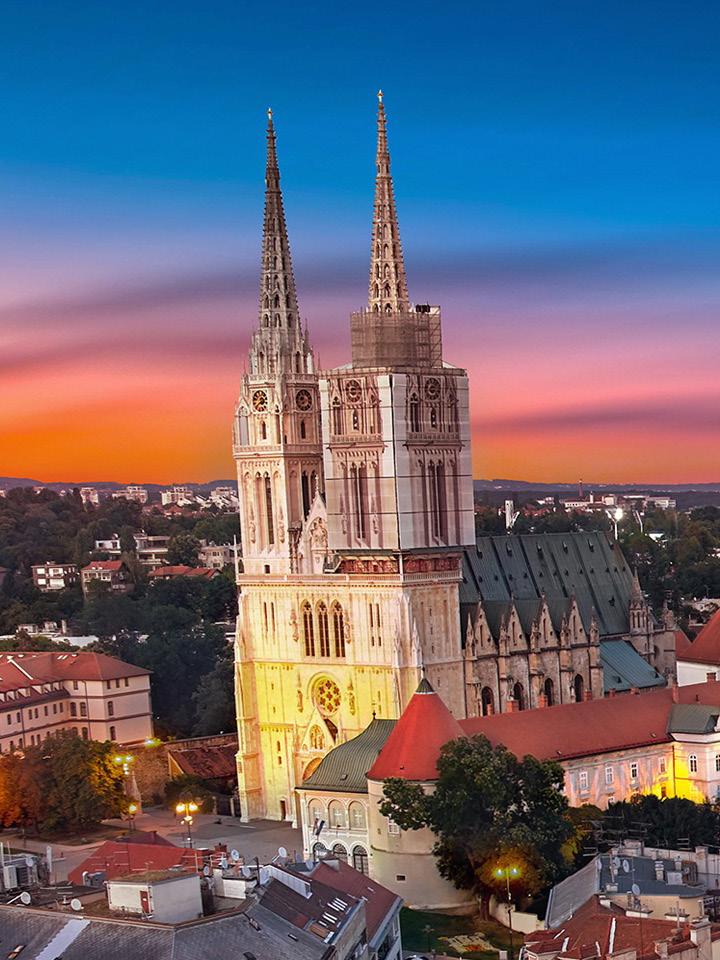
The ZAGREB World Dog Show 2024 was originally slated to take place in Ukraine. However, due to the country’s current warrelated challenges, Croatia stepped in to host this year’s edition at short notice. This meant they had only one year to organize an event of this magnitude: renting the showground, compiling the judges’ list, sending out invitations, arranging accommodations, and making all necessary preparations for catering, rings, parking, and entry forms. And they managed it all with great success.
One thing beyond their control was the weather. Alongside the Zagreb Spring Show, the event spanned 5 days. During the first two days and in the lead-up to the show, heavy rain created large puddles in the

parking area. While this wasn’t an ideal start for many exhibitors, surprisingly, there were few complaints. The weather was also initially quite cold. However, in the following days, there was a shift to the typical sunny and warm Croatian climate. Ironically, this change led to more grumbling, as being indoors under dim lighting while the sun beckoned outside wasn’t what many had hoped for. Despite this, most exhibitors were able to return to their homes, hotels, or campers to enjoy the rest of the day.
Regarding the venue, the organizers couldn’t be blamed for the weather or the condition of the halls, which are old and in need of renovation. Nonetheless, the pleasant surroundings with small green areas offering shade and resting spots helped compensate for this. Many attendees enjoyed the summer atmosphere, strolling between the different halls. However, the distances between the 9 halls required considerable physical exertion from handlers who often had to move swiftly between them. One significant complaint was the lack of clear information about navigating the venue. While there were large overview maps scattered around, they lacked indications of one’s current location or directions to specific
halls. Addressing this issue, along with adding signs directing visitors to different halls, could greatly enhance the attendee experience.
Upon arriving at the showground on the first day, I encountered a complaint from a trade stand holder regarding the consolidation of all commercial stands in one hall (the 10th), initially resulting in low visitor traffic. This setup posed challenges, as attendees were hesitant to leave their belongings and dogs unattended while shopping. However, as the weather improved and more people began exploring, the situation improved significantly. Subsequent interactions with other stand holders revealed their satisfaction
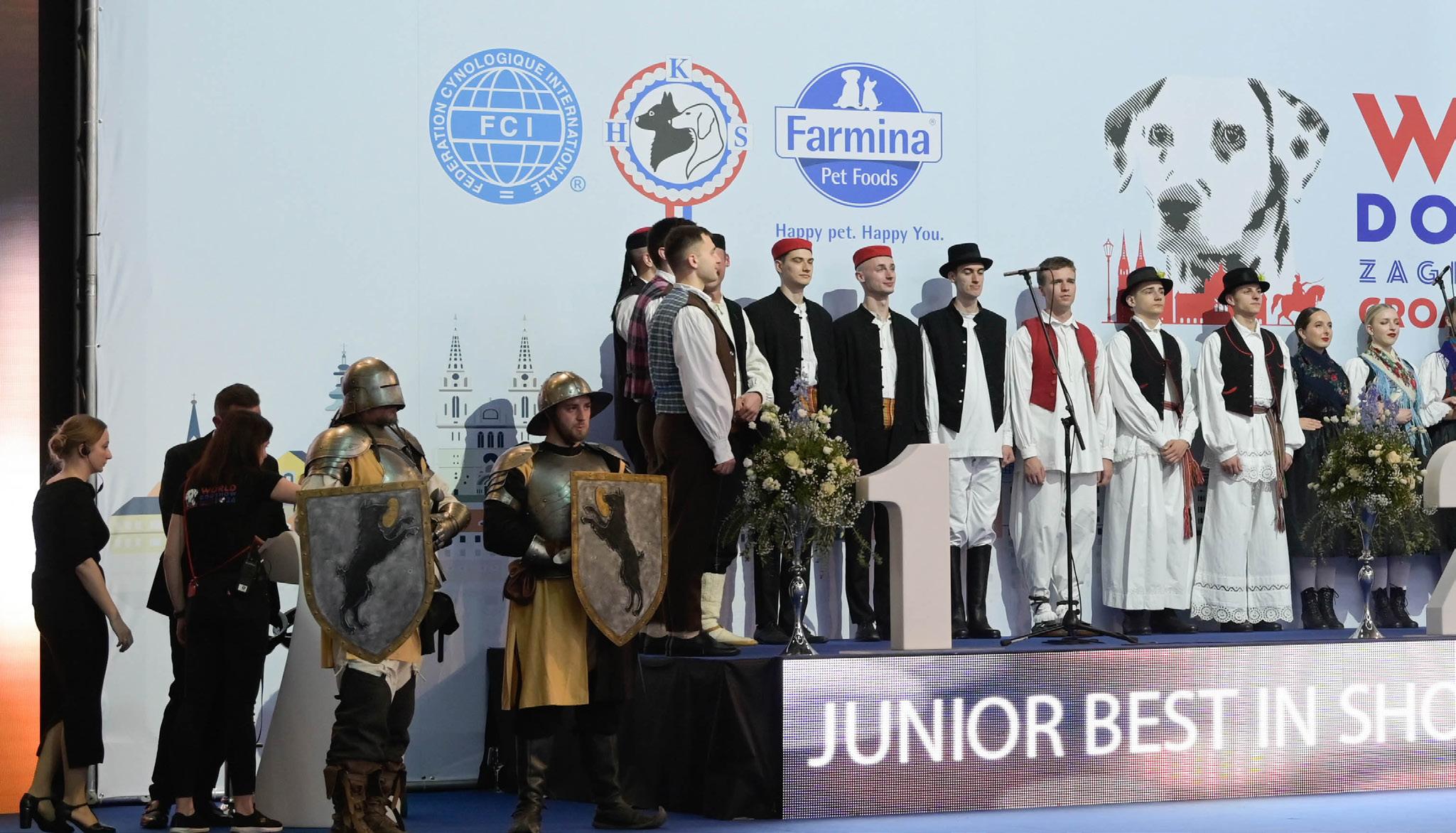
with the turnout. Given the substantial cost of trade stands at such large events, strategic placement where exhibitors and visitors must pass through them to access the rings is crucial.
Attending a World Dog Show is expensive, both for exhibitors and visitors alike. The entry fee for a dog was 125 EURO, with a discount for a second dog. Minor Puppies, Puppies, and Veterans were charged 105 EURO. Parking cost 10 EURO for outdoor and 60 EURO for indoor per day. Additionally, Mobil Homes ranged from 80 to 130 EURO per day depending on size and electricity requirements. Visitors over 12 years old had to pay 10 EURO. These expenses do not
include costs for travel, hotels, food, and other incidentals. This underscores the dedication of dog enthusiasts.
Organizing a show of this scale is also costly. Hall rentals have become prohibitively expensive, and top-notch accommodations are necessary for judges and VIP guests. While specific statistics on the number of judges invited were not provided, estimates suggest it could exceed 150. Many judges travel by plane and stay six to seven days in top city hotels, averaging around 1000 EURO per judge, which adds up significantly. Conversely, with 25,000 entries at an average of 100 EURO each, the total intake reaches 2,500,000
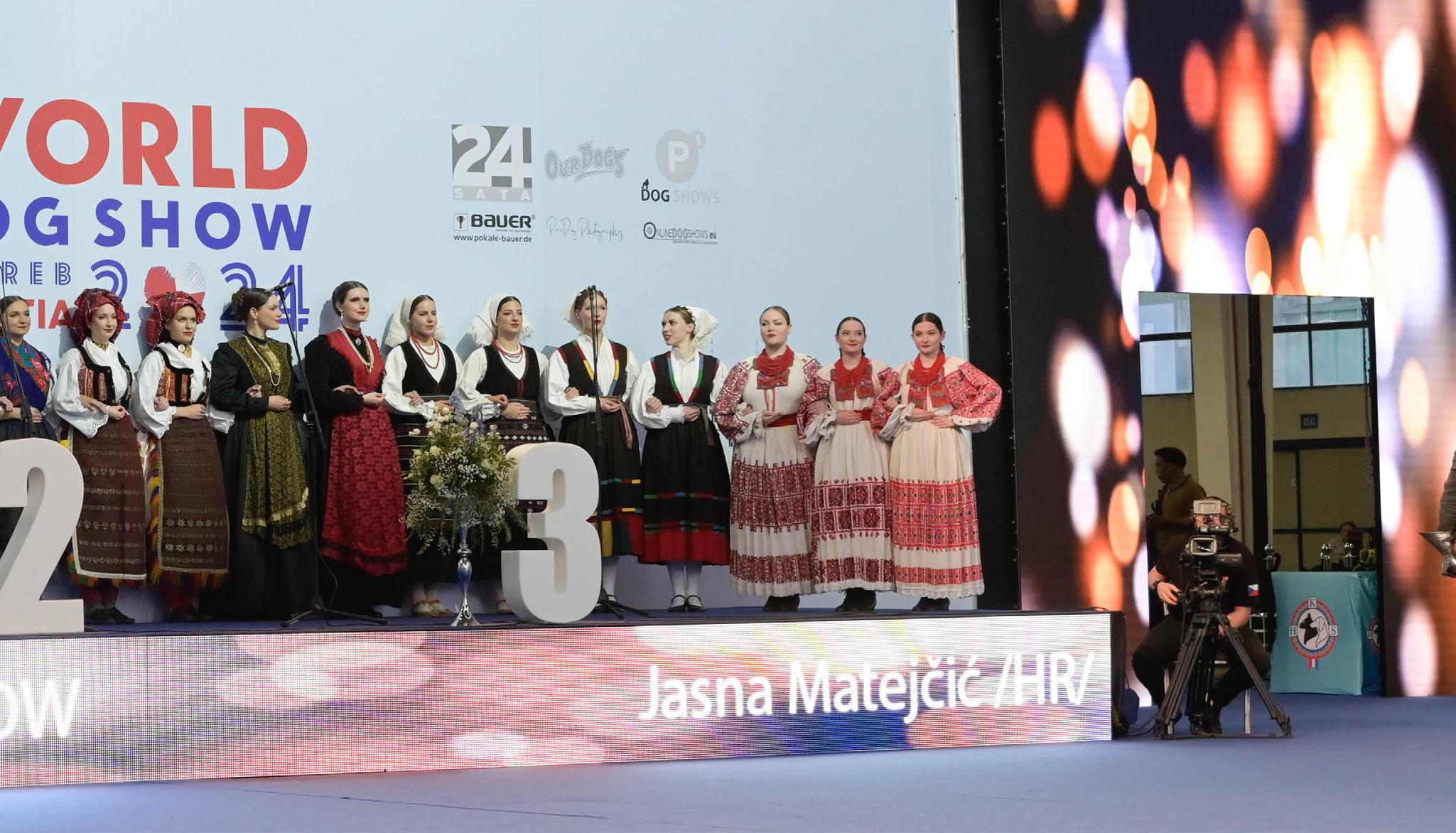
EURO. Income from parking and trade stands also contributes significantly. Despite high expenses, a substantial portion goes towards showground rental, with P1, the company renowned for organizing excellent main rings, also involved. Ring stewards receive nominal compensation alongside complimentary hotel accommodations and meals.
Securing the opportunity to host a World or European Dog Show is highly sought after by many countries. A well-organized and successful event can be financially rewarding, though it involves inherent risks and requires robust financial backing. Upfront costs for hall rentals, hotel reservations, and flight bookings are considerable. For this edition, however, it seems unlikely that the organizers will incur losses given the high number of entries.
In general, both inside and outside, the venue was kept clean. Compared to 20 years ago, exhibitors seem to grasp the importance of making a positive impression and demonstrating good behavior, understanding that the media often focuses more on cleanliness than on other aspects. It’s hard to gauge visitor numbers accurately, but the stairs leading to the main ring were consistently packed. The main ring hall featured a new roof with windows, allowing fresh air and sunlight to filter in, casting large bright rays across the showground. None of the halls were air-conditioned, which made the indoors slightly chilly during the initial days, but the sunny moments never made it
uncomfortably hot. Most halls had supporting pillars, though the main hall cleverly minimized obstruction with just one row of pillars on each side, ensuring an unobstructed view of the main ring. P1, the company responsible for the main ring, is renowned for its professionalism, evident in the evenly lit podium and improved balance with overhead spotlights. The setup, while classic, was deemed near perfection, prompting no need for unnecessary changes. The presentation was also top-notch, with one speaker fluent in the local language and another invited from the UK for the English version. The schedule was impeccably managed, neither too long nor too short, ensuring the show concluded on time each day.
Unfortunately, specific statistics beyond the president of the Croatian Kennel Club’s statement about 78 nationalities being represented were scarce. Breed-specific data, which used to be available in printed catalogs, is now missing from digital versions, despite the ease of compiling such information with modern technology. Personally, I prefer the tactile experience of flipping through a printed catalog, where finding information is instantaneous with a simple fold of the page.
The Spring Show held on Wednesday drew 3,743 entries, serving as an International Championship Show encompassing all breeds in a single day. Presumably, all dogs also participated in the World Dog Show, which spanned 4 days with a total of 14,850

entries. Given that dogs in the side shows were likely initially entered for the World Dog Show, the combined total likely approached 15,000 dogs. This number reflects a significant recovery post-Covid pandemic, though whether it will return to pre-pandemic levels remains uncertain. The cynological world faces ongoing challenges, with shifts in show focus and dwindling visitor engagement due to the high cost of publicity and scarce sponsorships. Awareness of such events among the general populace, especially in Western Europe, remains limited, though it might differ in Croatia.
Judging by personal experience across the four days of the event, it was particularly fascinating to witness numerous rare breeds, especially during the showcase of FCI nonrecognized breeds on Sunday. These breeds have yet to meet the minimum standards for
full FCI acceptance. Noteworthy encounters included the Chinese Red Dog or Laizhou Hong, the modern Ukrainian companion dog Odis, the Taigan from the steppes of central Asia—a blend of Saluki and Afghan Hound characteristics—the Sicilian herding dog Spino Degli Iblei, and the Deltari Ilir, resembling the Sarplaninac but originating from the Ilirian/ Macedonian region. The Mongolian Kennel Club Federation’s presentation of their native breed, the Mongol Bankhar, characterized by similarities to the Tibetan Mastiff but tailored more for herding and slightly smaller in size, was particularly distinctive, highlighted by their use of a traditional Mongolian nomadic tent (Joert) in place of a standard booth.
A show of this magnitude also provides valuable insights into breed popularity trends. Some breeds that were once highly favored, such as the American Staffordshire Terrier,
Staffordshire Bull Terrier, and Border Collie, now register lower entries (142, 138, and 158 respectively), trailing breeds like the Welsh Corgi and Whippet. Conversely, breeds like the Lagotto Romagnolo, previously rare at shows, are gaining traction with 116 entries. Italian Greyhounds (Piccolo Levriero Italiano) also seem to be capturing more hearts with 107 entries, while the Weimaraner’s popularity appears to be waning with 118 dogs. While these numbers are still robust, they mark a significant decline from their peak popularity years ago. Other breeds, however, continue to maintain enduring interest: 252 Golden Retrievers, 212 Labradors, 318 Poodles (all varieties), 348 Miniature Schnauzers (all colors), and 637 Dachshunds (all varieties) exemplify this sustained appeal. Similarly, breeds like Chihuahuas (177), Cavalier King Charles Spaniels (123), French Bulldogs (235), Miniature Spitz (227), Siberian Huskies (192), Collies (184), and English Bulldogs (168) also remain perennial favorites.
On Sunday, the finals program was efficiently managed, allowing exhibitors, judges, and visitors to depart at a reasonable time. The ceremonial proceedings were preceded by a presentation highlighting Croatia’s national breeds, including the Dalmatian, Croatian Sheepdog, Istrian Hounds, Tornjak (Croatian Shepherd Dog), and the Posavac Hound. Additionally, Croatia showcased an FCI non-recognized breed, the Mali Medimurski Pas or “Medi,” resembling a Corgi in size but
with the appearance and demeanor of an Australian Cattle Dog, albeit in different colors. This presentation was accompanied by a performance from a folkloric singing group.
The highlight of the event was the lineup of the 10 group winners, each representing exceptional quality, with only one crowned Best In Show. Mr. Niksa Lemo from Croatia had the honor of selecting the Best In Show winner. Four days earlier, the Afghan Hound had clinched the Best In Show title at the Croatian Spring Show and repeated the feat at this grand event with “Zaida Bint Muti Von Hausmann,” a 5-yearold bitch bred in Chile and co-owned by her breeder Mr. Podesta Ramon, along with Mr. Wilmer Santiago Armando Sobrado, D. Scott, James Pfeil, and Donahue from the United States. The Reserve Best In Show title went to the Old English Sheepdog “Airzeppeline Delia,” owned by Maria Louisa Moussoyianne Ep. Katshahnia from Greece, while the 3rd place went to the Scottish Terrier “Kriscots He’s A Rebel At De La Pomme,” owned by Phavida Jaruthavee from the United States. Limiting the podium to three places was a commendable decision by the organizers.
Looking ahead, the next edition of the World Dog Show will return to Helsinki, Finland. Having attended three times already, I can attest to Helsinki’s tradition of transforming such events into spectacular showcases. Nonetheless, the Zagreb edition was also highly enjoyable, although I hope future shows will not span five days to mitigate hotel costs.
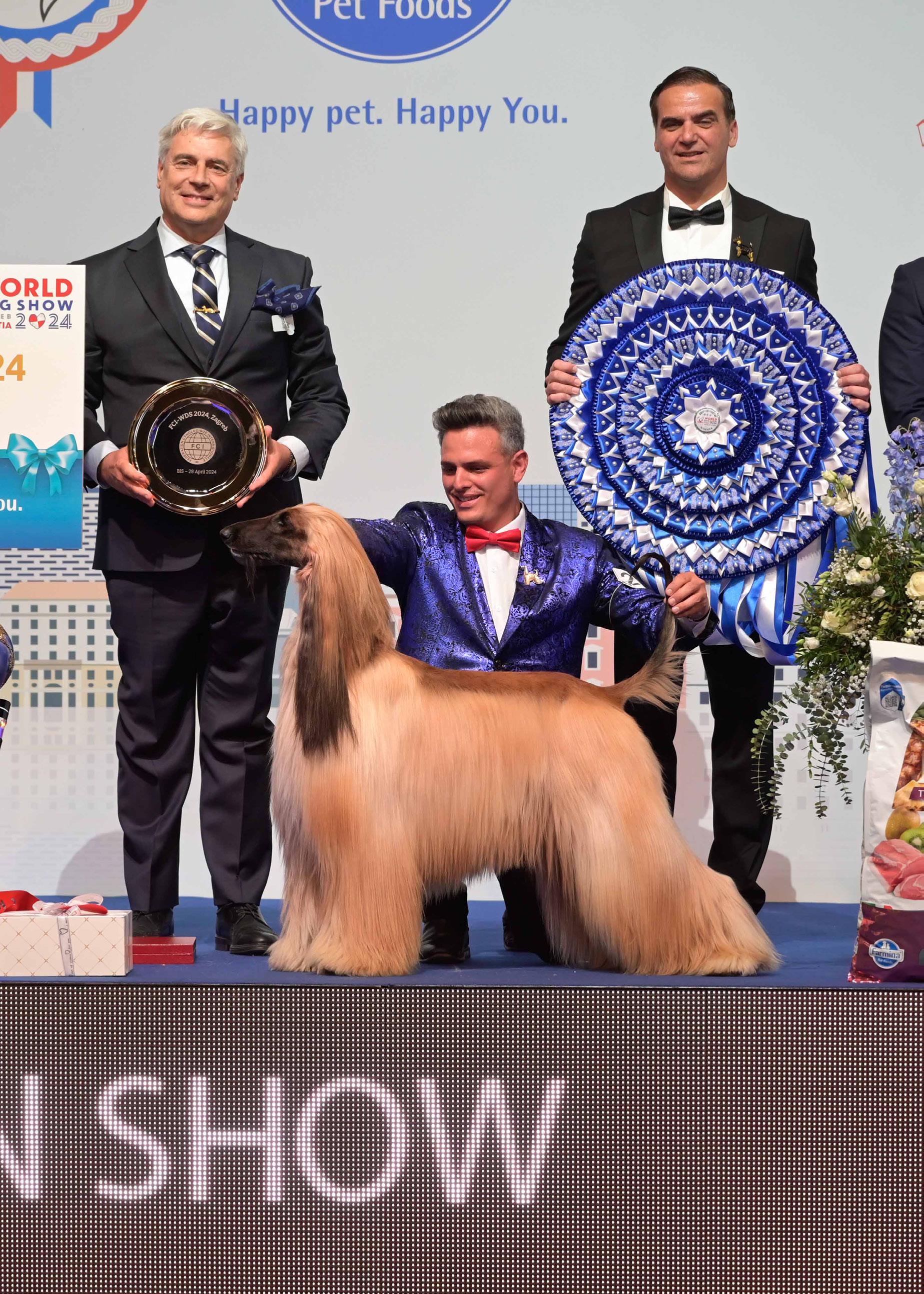


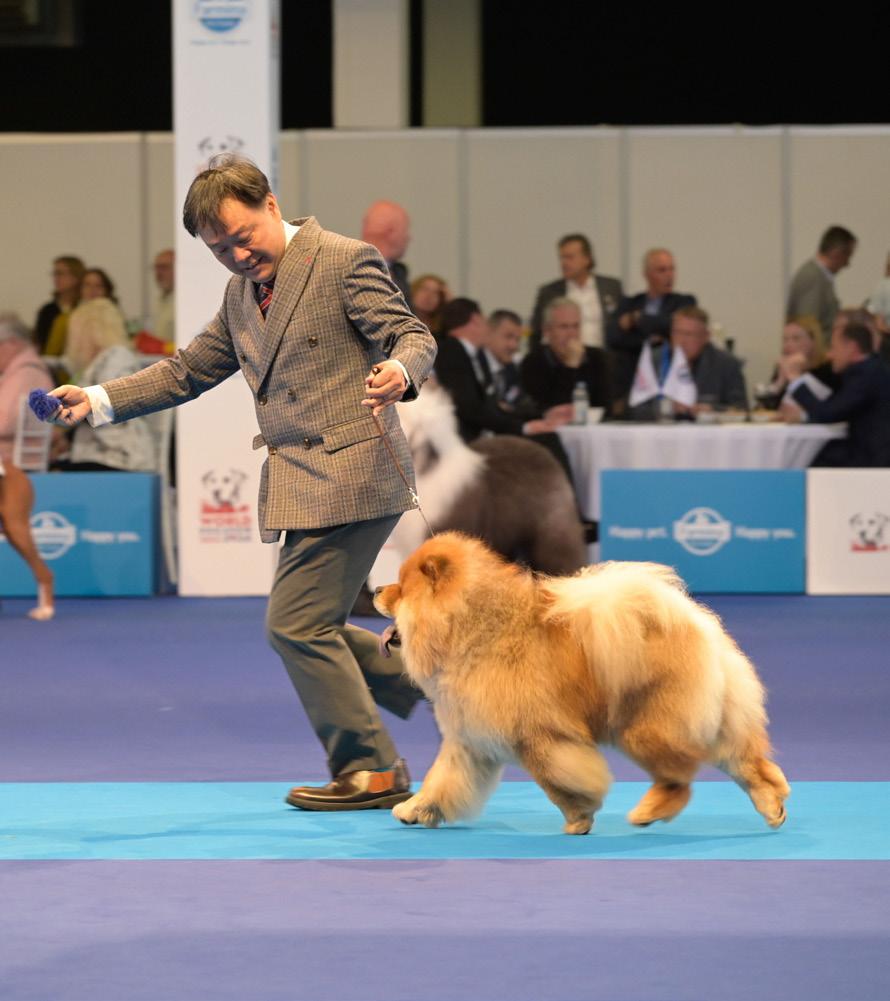







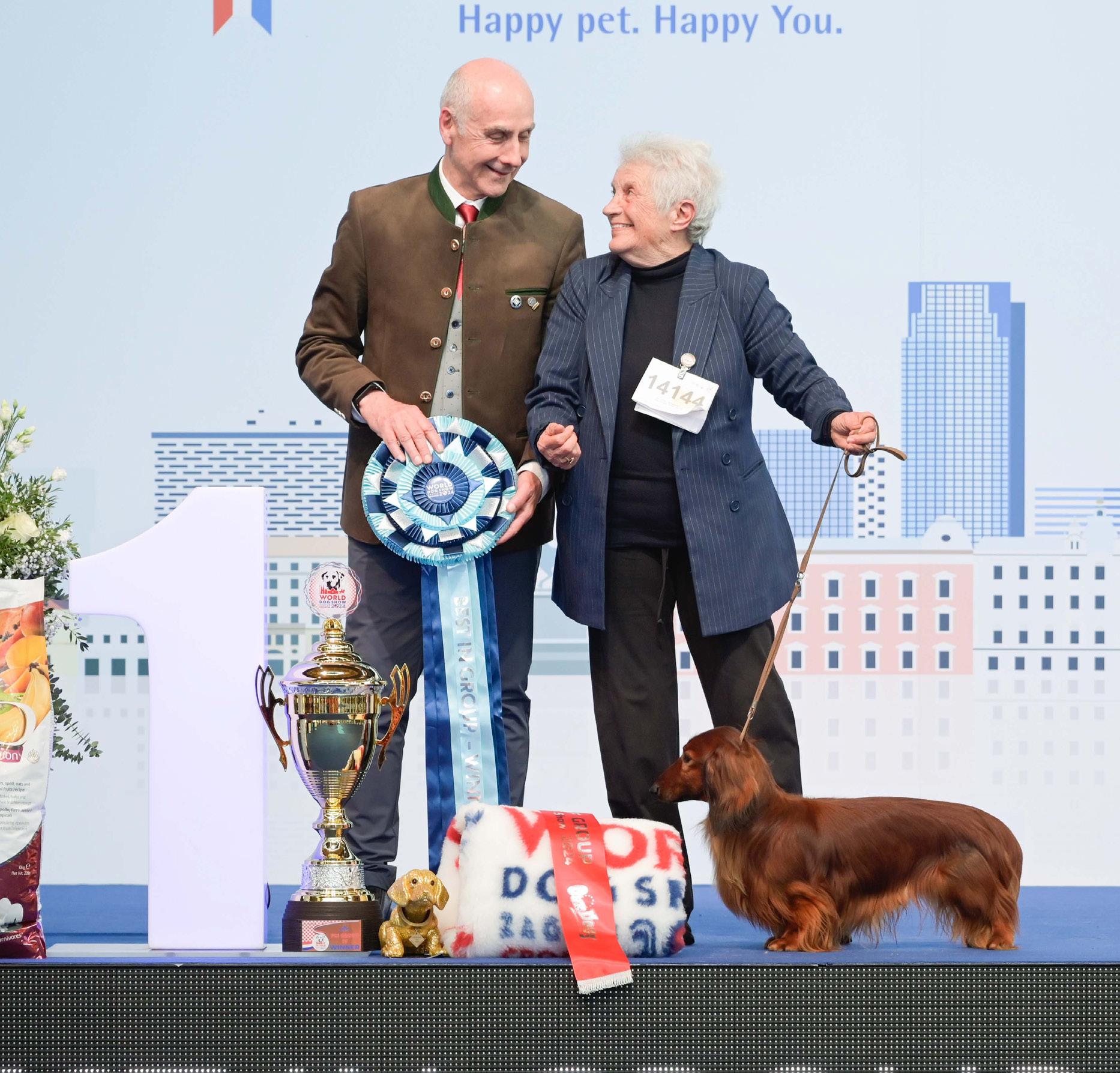


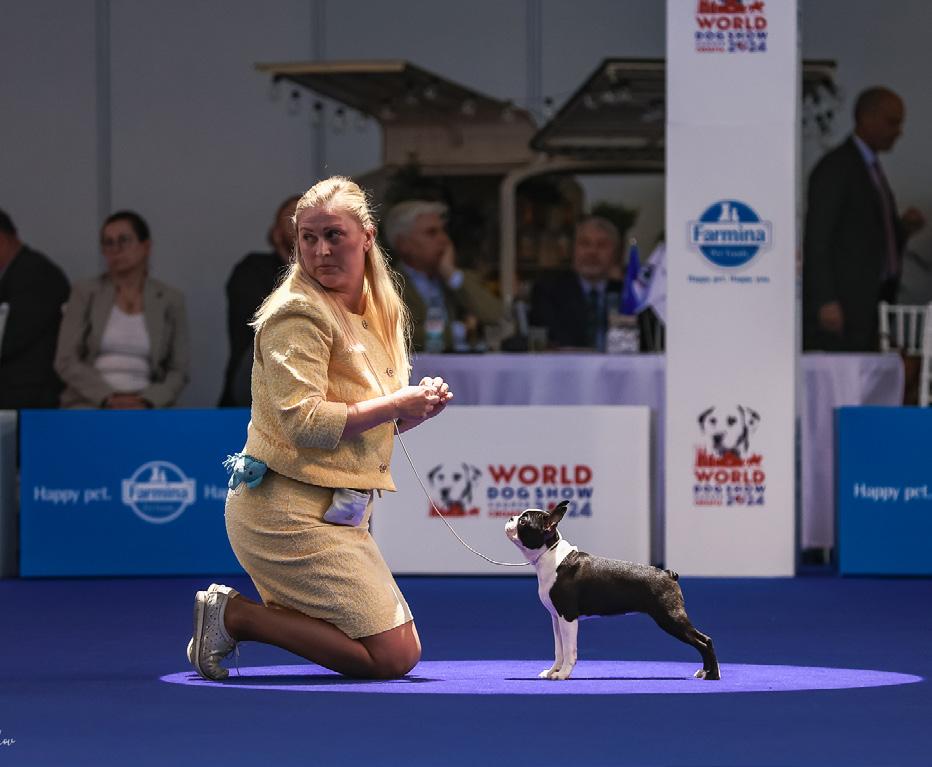


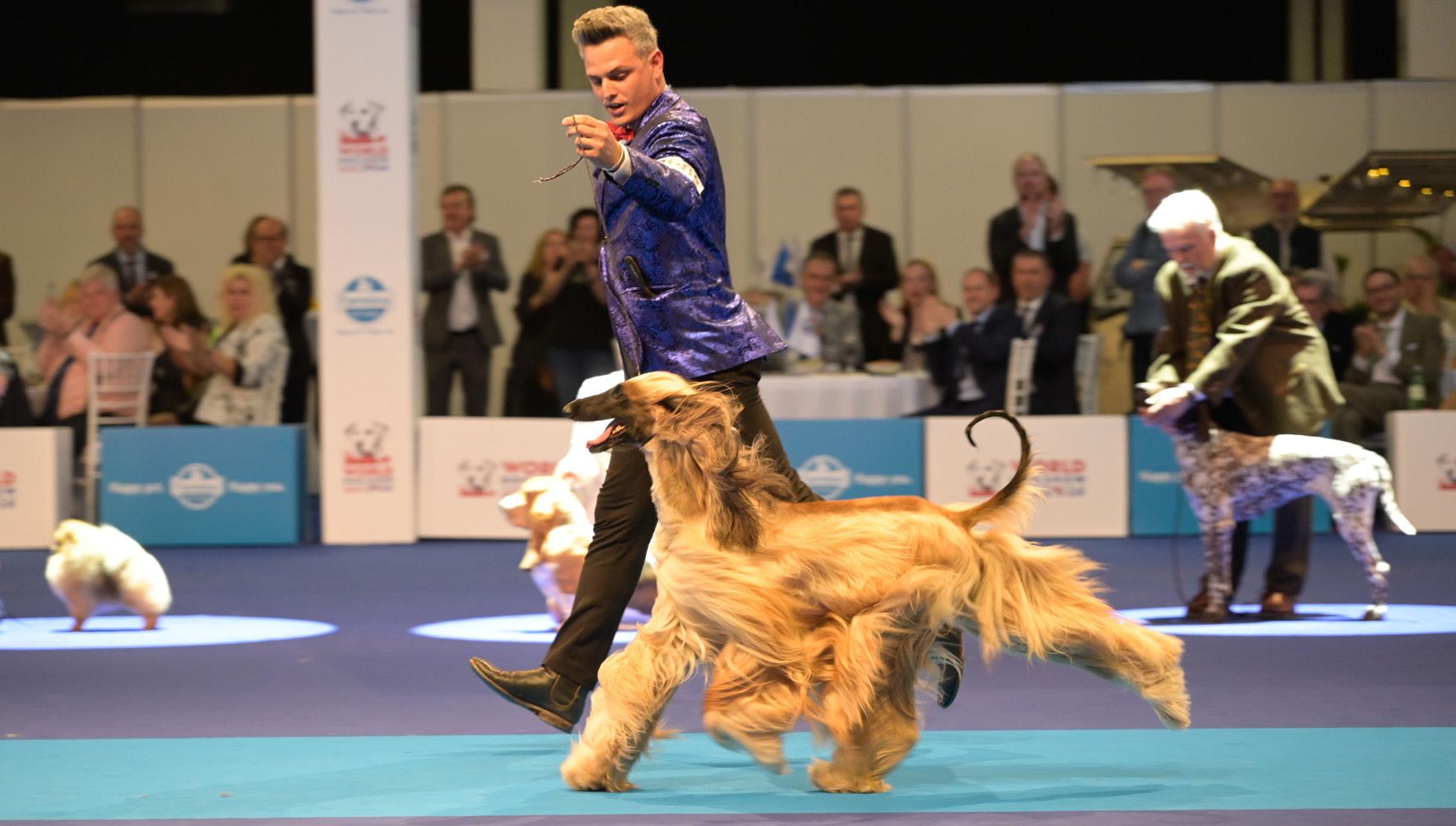


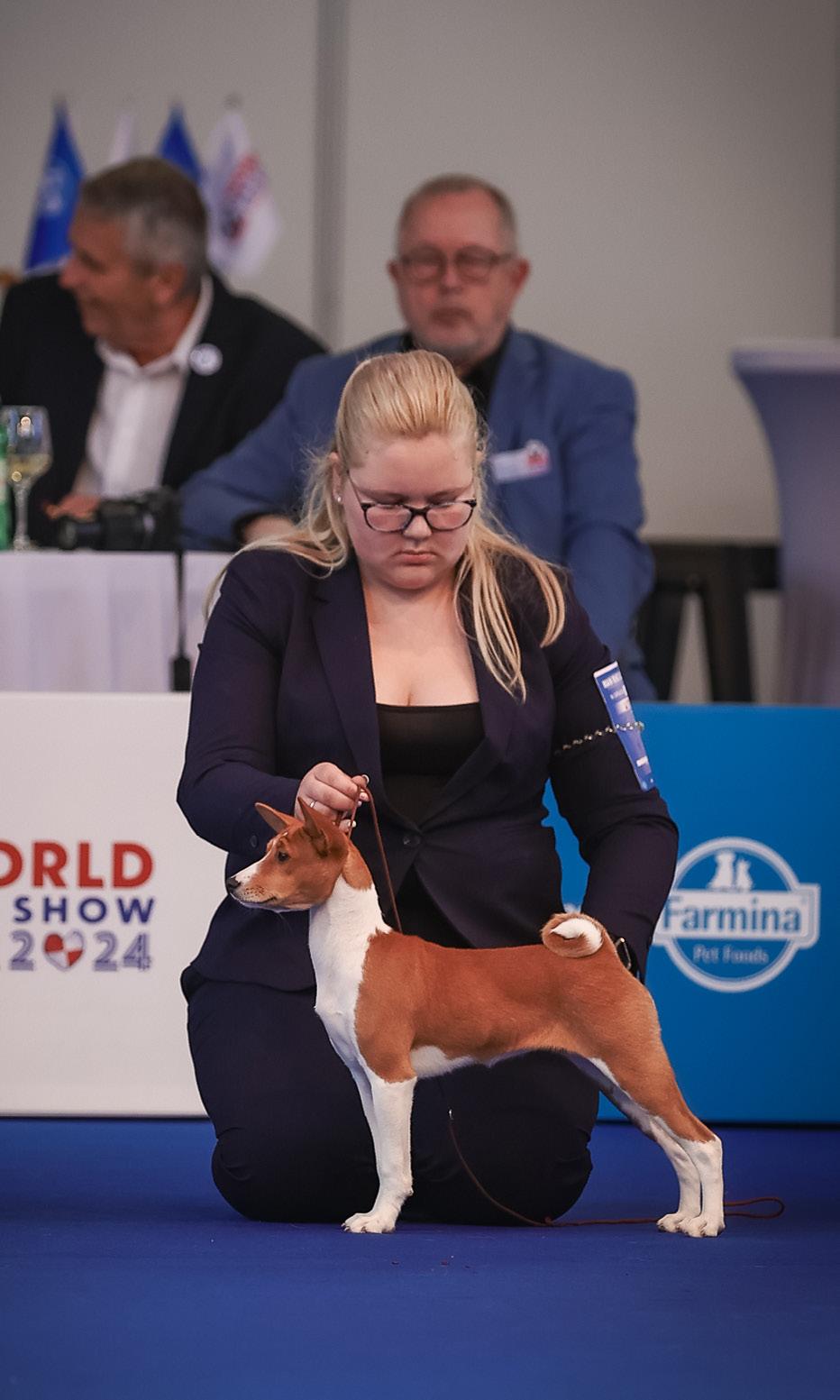
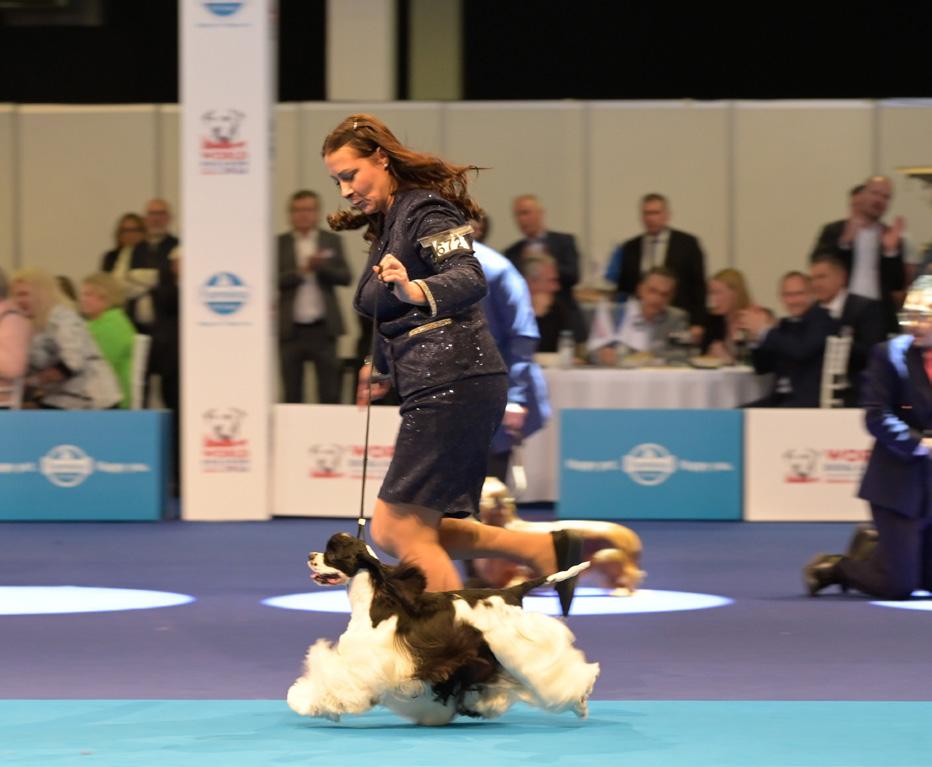

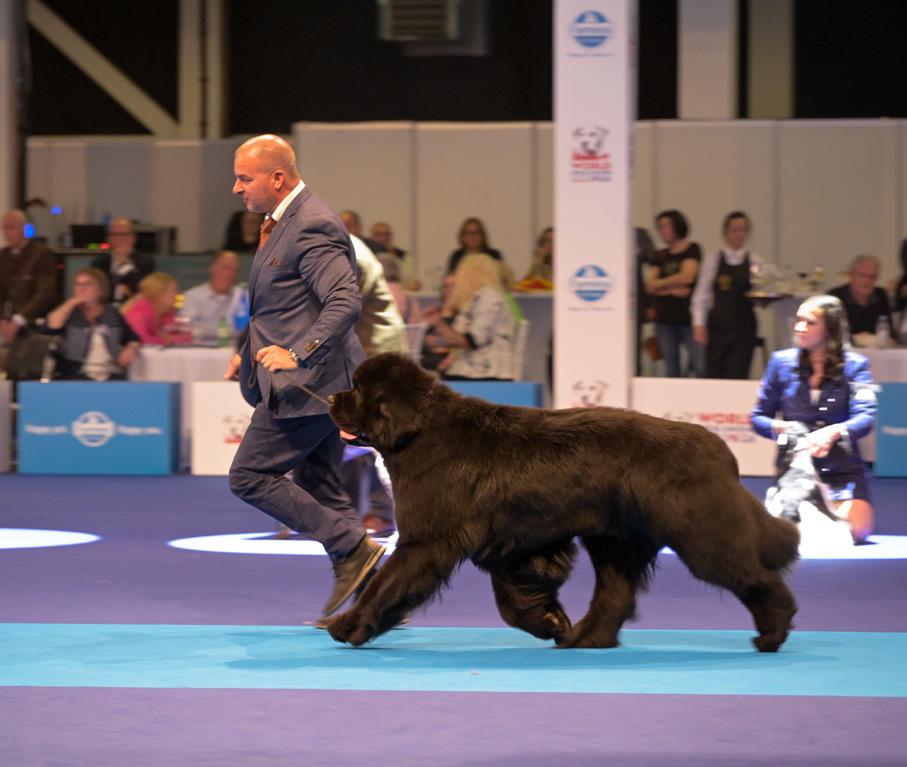









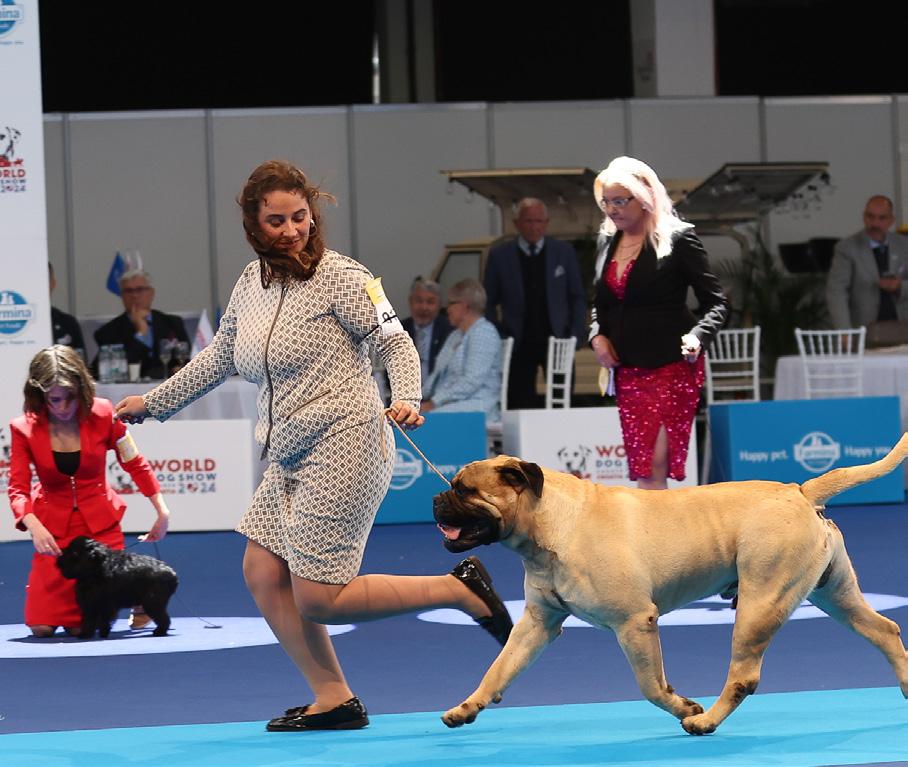
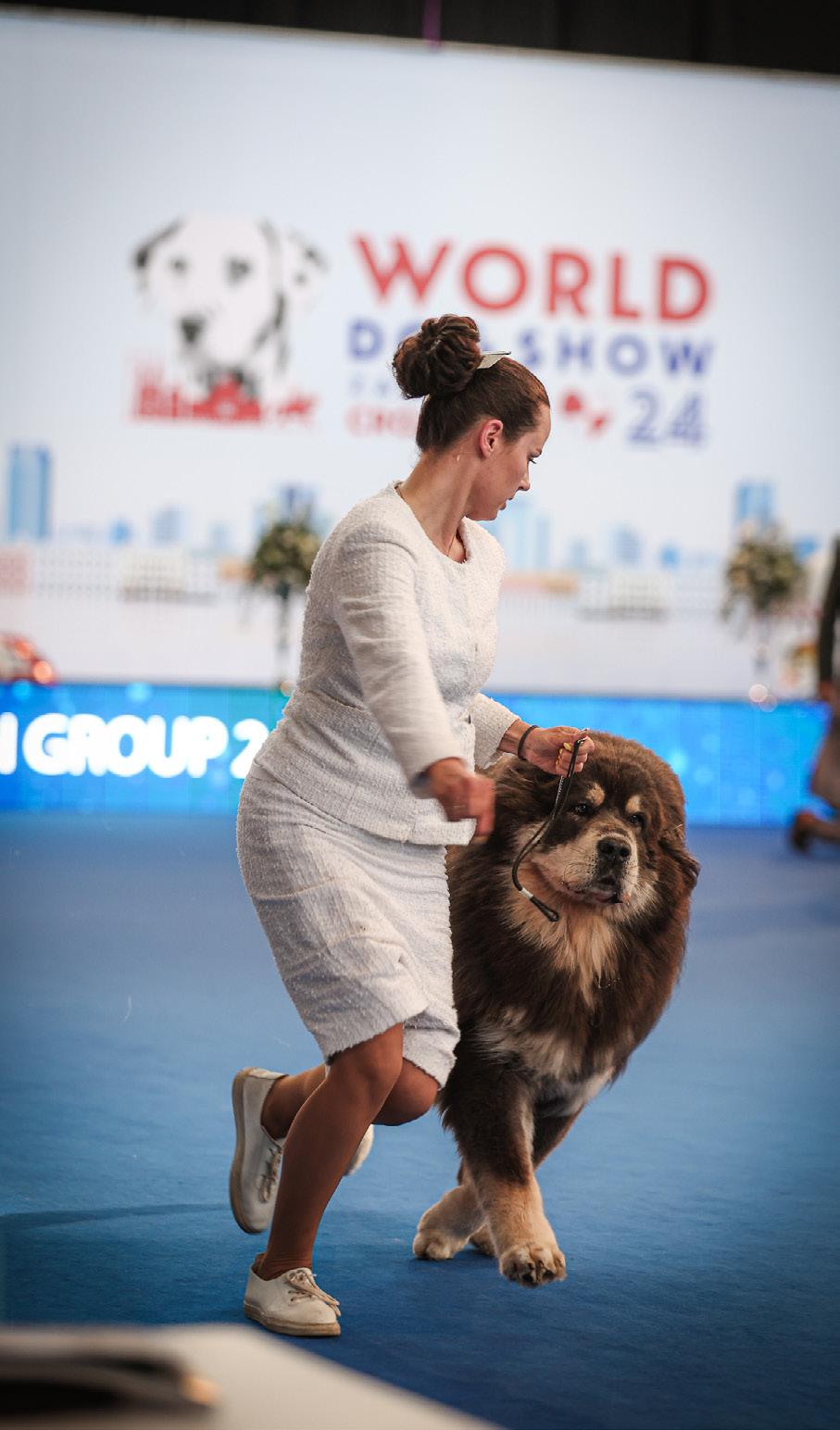



Zaida Bint Muti Von Haussman









